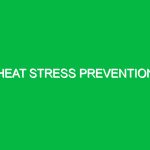In the realm of Health, Safety, and Environment (HSE), understanding the nuances of cold environments and worker safety is paramount. As industries expand into colder regions, from the oil rigs of the Arctic to construction sites in northern climates, the challenges posed by low temperatures become increasingly significant. Cold environments not only affect worker comfort but also pose serious health risks that can lead to accidents and injuries if not managed properly.
Understanding Cold Environments
Cold environments are characterized by low ambient temperatures that can adversely affect human health and operational efficiency. Such conditions can be found in various settings, including outdoor construction sites, refrigerated warehouses, and even during winter operations in temperate climates. The National Institute for Occupational Safety and Health (NIOSH) defines cold stress as the body’s inability to maintain its normal temperature when exposed to low temperatures.
The relevance of understanding cold environments in HSE cannot be overstated. Workers exposed to extreme cold face risks such as hypothermia, frostbite, and other cold-related illnesses. Moreover, the equipment used can become less effective in low temperatures, which can lead to increased risks of accidents. Therefore, implementing effective safety measures is crucial for maintaining a safe working environment.
Hazards and Risks in Cold Environments
Working in cold environments introduces a plethora of hazards that can jeopardize worker safety. Identifying these risks is the first step in mitigating them.
1. Cold Stress
Cold stress occurs when the body loses heat faster than it can produce it. Factors contributing to cold stress include wind chill, wet conditions, and prolonged exposure to low temperatures. Symptoms may range from shivering and fatigue to severe conditions like hypothermia and frostbite. A well-documented case involved a construction worker who suffered from frostbite after several hours of exposure without proper gear, highlighting the importance of appropriate clothing and break schedules.
2. Slips, Trips, and Falls
Ice and snow can create hazardous working conditions, leading to slips, trips, and falls. According to the Occupational Safety and Health Administration (OSHA), slips, trips, and falls are among the leading causes of workplace injuries, and the risk is significantly heightened in cold environments. A facility manager at a cold storage warehouse once shared, “We lost valuable time and incurred costs when our employees injured themselves on icy floors.” Proper maintenance and precautionary measures are essential to minimize these risks.
3. Decreased Visibility
Winter weather can reduce visibility due to snow, fog, or ice, making it difficult for workers to see hazards or for machinery operators to navigate safely. This is particularly critical in industries like construction or shipping, where machinery is prevalent. A truck driver recounted a near-miss due to poor visibility during a snowstorm, underscoring the importance of situational awareness in cold conditions.
4. Equipment Malfunction
Cold temperatures can impair machinery performance. Hydraulic fluids can thicken, batteries can drain, and metal components can become brittle. Such malfunctions not only pose risks to equipment but also endanger workers who rely on that equipment for their safety. A worker on a frigid oil rig experienced a hydraulic failure that led to a near-accident, emphasizing the need for regular maintenance checks and winterization processes.
Best Practices for Cold Environments and Worker Safety
To combat the hazards associated with cold environments, employers and workers alike must adhere to stringent safety protocols. Here are some detailed precautions and best practices to consider:
1. Proper Clothing and Personal Protective Equipment (PPE)
One of the most effective ways to prevent cold stress is through proper clothing. Workers should wear layered clothing that provides insulation while allowing moisture to escape. This includes:
- Base Layer: Moisture-wicking clothing that keeps the skin dry.
- Insulation Layer: Fleece or wool garments that trap heat.
- Outer Layer: Windproof and waterproof jackets that shield against the elements.
Additionally, gloves, hats, and thermal boots are essential. One winter, a team of workers on a construction site reported feeling much more comfortable and focused after a clothing upgrade, which allowed them to work longer without the distraction of cold discomfort.
2. Regular Breaks and Warm-Up Sessions
Employers should mandate regular breaks in warm areas to allow workers to recuperate. The NIOSH recommends a rotation schedule that includes short breaks every hour in temperatures below 32°F (0°C). A construction supervisor shared that implementing a rotation schedule not only improved morale but also reduced cold-related incidents significantly.
3. Training and Awareness
Training workers about the signs of cold stress and the importance of reporting symptoms can save lives. Regular training sessions should include information on how to recognize hypothermia and frostbite and the protocols for seeking help. Informing workers about the importance of hydration, even in cold weather, is also critical, as dehydration can exacerbate cold stress.
4. Site Maintenance and Safety Checks
Maintaining a safe work environment is essential. This includes regular inspections of the work site to identify and mitigate slip hazards, such as ice patches or snow accumulation. Ensuring proper lighting and visibility aids in preventing accidents. The facilities manager at a logistics company noted that proactive site maintenance during winter months drastically reduced their incident reports.
5. Equipment Preparation
Employers should ensure that all equipment is properly winterized before colder months. Regular maintenance checks, use of appropriate fluids, and ensuring batteries are in top shape can prevent equipment failure. An oil company’s winter preparation strategy included preemptive inspections, which minimized downtime and enhanced worker safety.
Regulations and Standards Governing Cold Environments
Several regulations govern worker safety in cold environments, primarily through OSHA and NIOSH guidelines. OSHA mandates that employers provide a workplace free from recognized hazards, which includes addressing cold stress. Specific guidelines related to cold weather safety are outlined in OSHA’s regulations, and adherence is vital.
Additionally, the American National Standards Institute (ANSI) and the National Fire Protection Association (NFPA) provide standards for personal protective equipment (PPE) that should be used in cold environments. Understanding these regulations not only protects workers but also shields employers from potential legal repercussions.
Conclusion
Cold environments present a unique set of challenges that can significantly impact worker safety. By understanding the hazards associated with these environments and implementing best practices, employers can create a safer workplace. Training, proper clothing, regular breaks, and maintaining equipment are essential components of an effective cold weather safety strategy. As industries continue to operate in colder climates, prioritizing worker safety will not only enhance productivity but also demonstrate a commitment to employee well-being.


